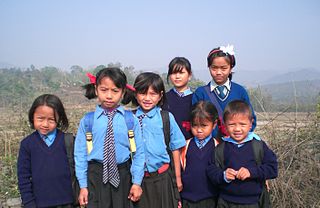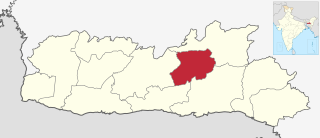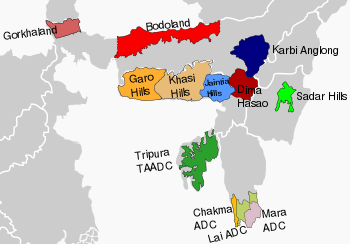
Meghalaya is a state in northeast India. Meghalaya was formed on 21 January 1972 by carving out two districts from the state of Assam: (a) the United Khasi Hills and Jaintia Hills and (b) the Garo Hills. The estimated population of Meghalaya in 2014 was 3,211,474. Meghalaya covers an area of approximately 22,429 square kilometres, with a length-to-breadth ratio of about 3:1.

The Tripura Tribal Areas Autonomous District Council(TTAADC) is an autonomous district council administering the Tiprasa-dominated areas of the state of Tripura, India. Its council and assembly are situated in Khumulwng, a town 26 km away from Agartala, the state capital.

Khasi Hills Autonomous District Council (KHADC) is an autonomous district council in the state of Meghalaya in India. It covers West Khasi Hills district, Eastern West Khasi Hills district, East Khasi Hills district and Ri Bhoi district. It is one of the three autonomous district councils within Meghalaya, and one of twenty-five autonomous regions of India. Between its foundation on 27 June 1952 and 14 June 1973 it was known as the United Khasi-Jaintia Hills District Council. The total area of the Khasi Hills Autonomous District Council is 11,718 km2 having a population of 1,578,375 as of 2011.

Jaintia Hills Autonomous District Council (JHADC) is an autonomous district council in the state of Meghalaya in India. It is one of the three autonomous district councils within Meghalaya, and one of twenty-five autonomous regions of India. Present Jaintia hills was a part of historical Jaintia Kingdom. It was formed as the Jowai Autonomous District Council on 23 November 1964 from the Jowai Subdivision of the United Khasi-Jaintia Hills District – adopting its current name on 14 June 1973.

The Meghalaya Legislative Assembly is the unicameral legislature of the Indian state of Meghalaya.
Williamson Ampang Sangma, was a Garo leader, and the first Chief Minister of Meghalaya. He was also the first Governor of Mizoram among the Garos in 1989.

The West Karbi Anglong district is an administrative unit in the Indian state of Assam. It is a relatively new district formed out of the existing Karbi Anglong district in 2016. The administrative headquarters of the district is located at Hamren. The district is a part of the Karbi Anglong Autonomous Council and is administered according to the provisions of the Sixth Schedule of the Indian Constitution.

The Meghalaya Legislative Assembly election was held on 27 February 2018 to elect 59 of 60 members to the Meghalaya Legislative Assembly, with the results declared on 3 March. The scheduled election in Williamnagar constituency was delayed to an undetermined date following the death of Nationalist Congress Party candidate Jonathone Sangma in an IED blast in East Garo Hills district on 18 February 2018. The incumbent Indian National Congress government, led by Chief Minister Mukul Sangma, attempted to win re-election for the third consecutive time.

The hill tribes of Northeast India are hill people, mostly classified as Scheduled Tribes (STs), who live in the Northeast India region. This region has the largest proportion of scheduled tribes in the country.

South Tura is one of the 60 Legislative Assembly constituencies of Meghalaya state in India. It is part of West Garo Hills district and is reserved for candidates belonging to the Scheduled Tribes. It falls under Tura Lok Sabha constituency and its current MLA is Conrad Sangma of National People's Party.

North Tura is one of the 60 Legislative Assembly constituencies of Meghalaya state in India. It is part of West Garo Hills district and is reserved for candidates belonging to the Scheduled Tribes. It falls under Tura Lok Sabha constituency and its current MLA is Thomas A. Sangma of National People's Party.

Karbi Anglong Autonomous Council (KAAC) is an autonomous district council in the state of Assam, India for development and protection of tribals living in area namely Karbi Anglong and West Karbi Anglong district. The council is constituted under the Sixth Schedule of the Constitution of India and administratively functions under the Government of Assam. Its headquarters is in Diphu, Karbi Anglong district. The total administrative area of the Council is 10,434 sq. km with a population of 961,275 as of 2011.

Rangsakona is one of the 60 Legislative Assembly constituencies of Meghalaya state in India.

Ampati is one of the 60 Legislative Assembly constituencies of Meghalaya state in India.

Salmanpara is one of the 60 Legislative Assembly constituencies of Meghalaya state in India.

Rongara Siju is one of the 60 Legislative Assembly constituencies of Meghalaya state in India. The constituency was created after the passing of the Delimitation of Parliamentary and Assembly constituencies, 2008. It had its first election in 2013. It is part of South Garo Hills district and is reserved for candidates belonging to the Scheduled Tribes.

Eastern West Khasi Hills is a district in the Indian state of Meghalaya, located approximately 25 kilometres (16 mi) west of the state capital of Shillong. It was created in 2021, after bifurcation of existing West Khasi Hills district. The territories which make up the district recorded a total population of 131,451 in the 2011 census. The district headquarters is the town of Mairang.
Muhammad Akramozzaman was an Indian Bengali politician. He was the former two-time member of the Meghalaya Legislative Assembly for the Phulbari constituency in West Garo Hills district.

Chandigre is a village in the West Garo Hills district, Meghalaya, India. Chandigre is located close to the Nokrek Biosphere Reserve. The economy is largely agrarian, following the traditional jhum system of rotational slash-and-burn cropping to a limited extent. Most of the houses are traditional bamboo buildings. The Chandigre Rural Tourist Resort offers tourists an experience of the traditional Garo way of life.
Arbinstone B. Marak is an Indian politician from Meghalaya. He is a member of the Meghalaya Legislative Assembly from Selsella Assembly constituency, which is reserved for Scheduled Tribe community, in West Garo Hills district. He won the 2023 Meghalaya Legislative Assembly election representing the National People's Party (India).






















